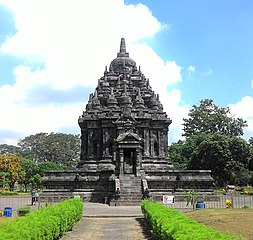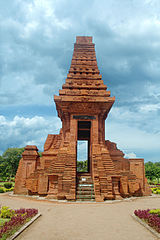Candi Styles
Soekmono, an Indonesian archaeologist, has classified the candi styles into two main groups: a central Java style, which predominantly date from before 1,000 CE, and an eastern Java style, which date from after 1,000 CE. He groups the temples of Sumatra and Bali into the eastern Java style.
Central Java Style
Bubrah Temple (Prambanan)
Eastern Java Style
Bajang Ratu Gate (Trowulan)

| Parts of the temple | Central Java Style | Eastern Java Style |
|---|---|---|
| Shape of the structure | Tends to be bulky | Tends to be slender and tall |
| Roof | Clearly shows stepped roof sections, usually consist of 3 parts | The multiple parts of stepped sections formed a combined roof structure smoothly |
| Pinnacle | Stupa (Buddhist temples), Ratna or Vajra (Hindu temples) | Cube (mostly Hindu temples), sometimes Dagoba cylindrical structures (Buddhist temples) |
| Portal and niches adornment | Kala-Makara style; Kala head without lower jaw opening its mouth located on top of the portal, connected with double Makara on each side of the portal | Only Kala head sneering with the mouth complete with lower jaw located on top of the portal, Makara is absent |
| Relief | Projected rather high from the background, the images was done in naturalistic style | Projected rather flat from the background, the images was done in stylized style similar to Balinese wayang image |
| Layout and location of the main temple | Concentric mandala, symmetric, formal; with main temple located in the center of the complex surrounded by smaller perwara temples in regular rows | Linear, asymmetric, followed topography of the site; with main temple located in the back or furthermost from the entrance, often located in the highest ground of the complex, perwara temples is located in front of the main temple |
| Direction | Mostly faced east | Mostly faced west |
| Materials | Mostly andesite stone | Mostly red brick |
There are material, form, and location exceptions to these general design traits. While the Penataran, Jawi, Jago, Kidal and Singhasari temples, for example, belong to the eastern Java group, they use andesite stone similar to the Central Java temple material. Temple ruins in Trowulan, such as Brahu, Jabung and Pari temples use red brick. Also the Prambanan temple is tall and slender similar to the east Java style, yet the roof design is Central Javan in style. The location also do not always correlate with the temple styles, for example Candi Badut is located in Malang, East Java, yet the period and style belongs to older 8th century central Javanese style.
The earlier northern central Java complexes, such as the Dieng temples, are smaller and contain only several temples which exhibit simpler carving, whereas the later southern complexes, such as Sewu temple, are grander, with a richer elaboration of carving, and concentric layout of the temple complex.
The Majapahit period saw the revival of Austronesian megalithic design elements, such stepped pyramids (punden berundak). These design cues are seen in the Sukuh and Cetho temples in Mount Lawu in eastern Central Java, and in stepped sanctuary structures on the Mount Penanggungan slopes that are similar to meso-American stepped pyramids.
